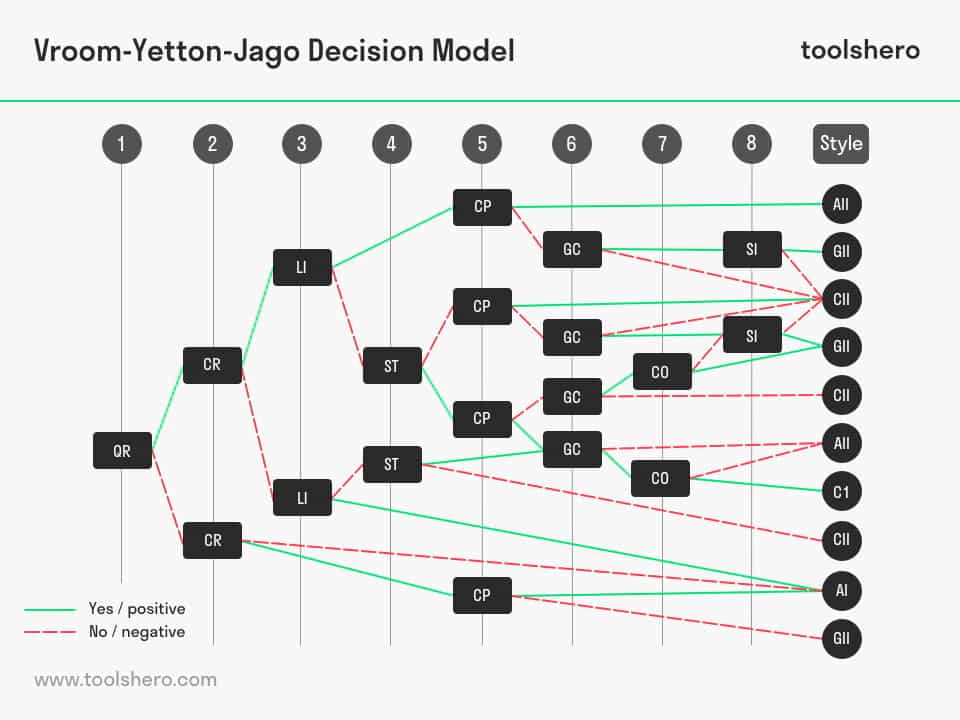Vroom Yetton Jago Decision Model

Vroom Yetton Jago Decision Model: this article provides a practical explanation of the Vroom Yetton Jago Decision Model. After reading this article, you’ll understand the basics of this powerful decision making
What is a Vroom Yetton Jago Decision Model?
The Vroom Yetton Jago Decision Model is a model for decision-making that’s based on situational leadership. The model can be used by everyone, irrespective of rank or position and helps to choose the style of leadership in various decision situations.
In some business situations, it’s better that the leader takes all the decisions, whereas in other situations it’s better if the group has a say.
The Vroom Yetton Jago Decision Model helps to choose the right style by having the user answer a series of questions with either yes or no to come to the final decision. This series of questions is presented in the form of a matrix. After answering the questions, the user immediately sees what method best suits the situation concerned (leadership and decision).
According to this decision making model, three specific factors have direct influence on the method for decision-making: quality, collaboration and time. The series of questions creates clarity regarding the influence of these factors in the situation.
Subsequently, the model displays how the leader should make good decisions: independently, together with the group or after obtaining advice. There are five different situations in total in which a different approach is desired and effective.
The Vroom Yetton Jago Decision Model was originally developed by Victor Vroom and Phillip William Yetton in 1973, and it was expanded 15 years later by supplementations from Arthur G. Jago.
Three Important Factors in Decision-making
When a decision must be made, the desired management style and the degree of participation of team members are influenced by three important factors.
The Vroom Yetton Jago Decision Model therefore demands proper thought before answering the series of questions.
By considering the three specific factors, better insight is formed about the decision to be made. The following three factors are important in each decision situation:
The Quality of the Decision
The quality of the decision to be taken is about how much impact the decision will have and how important it is to find the right solution. The higher the decision’s quality, the more people must be involved in the process.
Involvement and Collaboration
Involvement and collaboration concerns the question of how important it is that everyone agrees to the decision in a team. Depending on how important this is, the degree of participation must be raised or lowered.
Time Constraints
How much time is there to take decision? If there’s little time, a fast autocratic approach might be more desirable, as there’s no time to lose in certain situations. If there’s a lot of time, there are more options to involve more team players in the process.
The way in which these factors influence the situation helps the user to determine what the best leadership style and decision method are.
Five Decision-making Styles
The Vroom Yetton Jago Decision Model distinguishes between three leadership styles and five different processes:
Autocratic I (A1)
In this decision process, the leader uses the available information to make a decision independently. The opinion of team members or external parties is not consulted in this case. Although the decision itself is not dependent upon the team members, and their opinion doesn’t matter, it is important that the made decision is communicated openly and clearly towards the team.
Autocratic II (A2)
Here too, the leader independently makes the decision, but the difference with autocratic style 1 is that the leader has a bit more time and gathers information from team members or external parties.
The team members don’t know why information is requested from them and don’t think about the situation, alternative or eventual choice.
Consultative I (C1)
The leader adopts a consulting role and actively takes the lead to have team members individually give their opinion about the situation, the problem and the decision to be made.
Here, the team’s involvement is higher than in the autocratic decision-making style. However, the decision is still made by the leader; he can choose to disregard the team’s opinion and input when these haven’t changed his outlook on the situation.
Consultative II (C2)
Where the leader requests the individual opinions from the team members in the first consulting style, he brings the team together in a group meeting for a discussion in the second.
Ideas and suggestions are asked for in this meeting. Here, the leader shares the problem and the situation with the group, but eventually, the leader is still the one to individually make the decision.
Group II (G2)
The group as a whole makes the decision. The leader presents the situation and the problem to the group, identifies alternatives and makes a consensus decision and stimulates team commitment.
The leader purely plays the role of facilitator and accepts the decision of the group without considering his own opinion or vision.
In order to determine which of these styles and processes is most suitable, taking into account the three factors, the decision tree from the Vroom-Yetton-Jago Decision Model must be completed.
Determining the Right Decision Style
Victor Vroom, Phillip Yetton and Arthur Jago developed eight questions that must be answered with yes or no to arrive at the right decision style. All the questions have a certain theme. These themes are represented by the abbreviations in the model. The eight questions must be answered in the order below by the leader so as to determine the right leadership style and decision method.
- Is the quality of the decision very important? Are the consequences of possible failure significant? – QR (quality requirement)
- Is a successful result dependent upon the team members? – CR (commitment requirement)
- Does the leader have sufficient information to make an important decision alone? – LI (leader’s information)
- Has the problem been defined and structured properly so it can be easily understood what needs to be done and what a good solution might be? ST – (problem structure)
- When a leader makes the decision himself, is it likely to assume that the team is sufficiently involved and motivated and will accept the decision? – CP (commitment probability)
- Are the goals of the team consistent with the goals of the organisation that have been set to define a successful solution? – GC (goal congruence)
- If the team has to make a decision, are conflicts expected about the decision to be made and solution? – CO (subordinate Conflicts)
- Do the team members and other external parties have sufficient information to make an important decision? – SI (subordinate information)
Use the visualisation of the model to answer the questions step by step and arrive at the right style of decision-making. All the way to the right in the image of the model, an arrow is used to indicate which decision method is most suitable for the situation.
Pros and Cons Vroom Yetton Jago Decision Model
The main advantage of the Vroom Yetton Jago Decision Model is that it can flexibly be used in many situations.
The capacity to organise the process is a quality of the model many a leader could use to their advantage. Each situation demands a different approach, and practically every situation can be considered with this model.
On the other hand, the model also has several shortcomings. For instance the personal factors and characteristics of the leader aren’t considered, and the questions in the model might not be specific enough to determine the ideal decision method.
Additionally, users of the model also indicate that they have doubts regarding the Vroom Yetton Jago Decision Model’s effectiveness to determine the decision strategy for important decisions the outcomes of which influence a large team.
It’s Your Turn
What do you think? Do you recognise the explanation of the Vroom-Yetton-Jago Decision Model? How do you think you can apply this decision model in your environment? What do you believe are factors that must be taken into account in such important decision situations? Do you have any additions or tips?
Share your experience and knowledge in the comments box below.
More information
- Jago, A. G., & Vroom, V. H. (1980). An evaluation of two alternatives to the Vroom/Yetton normative model. Academy of Management Journal, 23(2), 347-355.
- Vroom, V. H., & Jago, A. G. (1988). The new leadership: Managing participation in organizations. Prentice-Hall, Inc.
- Vroom, V. H., & Jago, A. G. (2007). The role of the situation in leadership. American psychologist, 62(1), 17.
How to cite this article:
Janse, B. (2018). Vroom Yetton Jago Decision Model. Retrieved [insert date] from ToolsHero: https://www.toolshero.com/decision-making/vroom-yetton-jago-decision-model/
Published on: 21/12/2018 | Last update: 07/04/2022
Add a link to this page on your website:
<a href=”https://www.toolshero.com/decision-making/vroom-yetton-jago-decision-model/”>Toolshero: Vroom Yetton Jago Decision Model</a>













